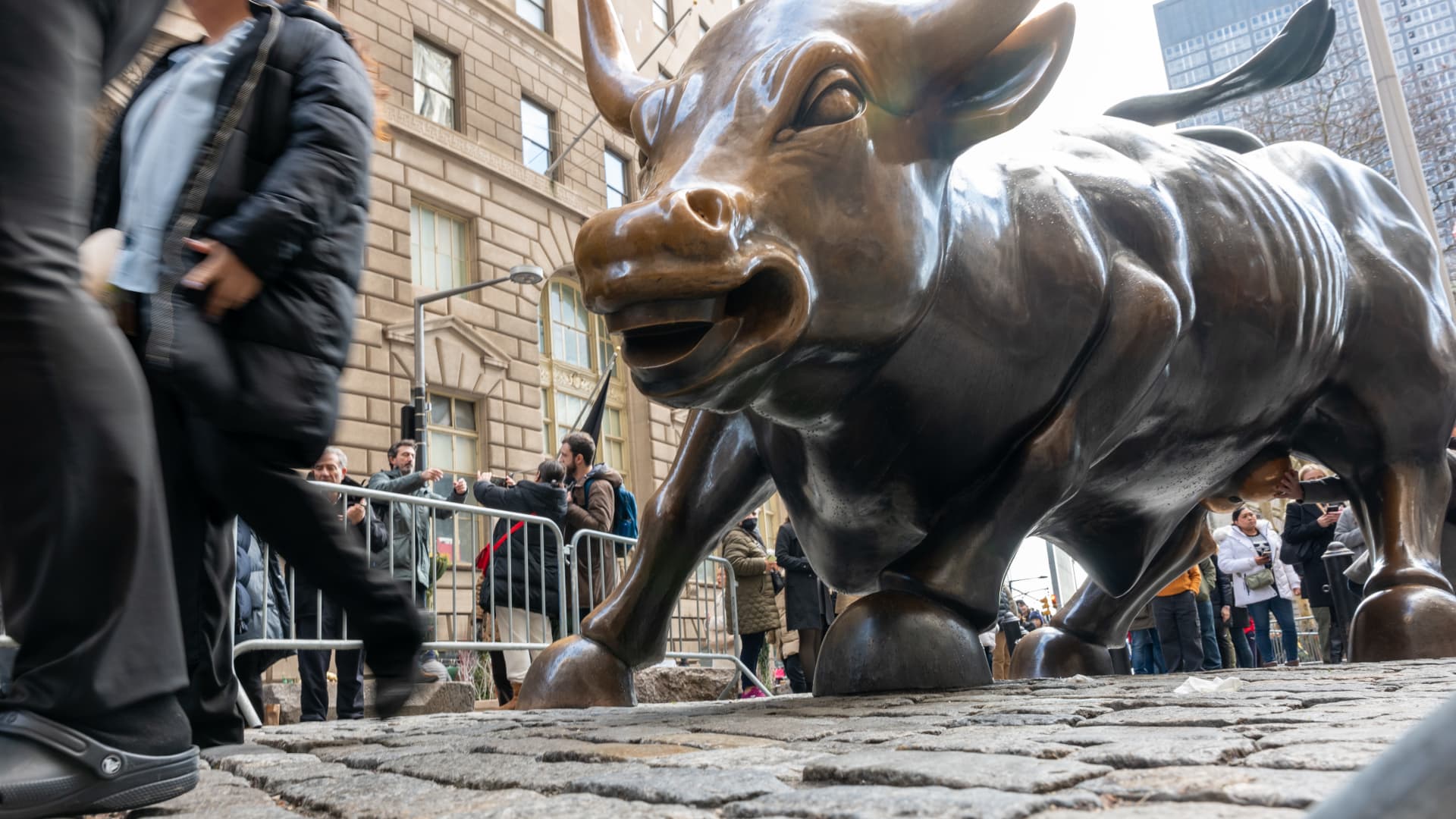People walk by the New York Stock Exchange in New York City on Dec. 29, 2023.
Spencer Platt | Getty Images
The Dow Jones Industrial Average reached a key milestone, the latest in a more than 100-year ascent that’s involved an everchanging group of stocks.
The closely followed average on Thursday broke above the 40,000 marker for the first time in its history. But the index today looks far different than it did a century ago — or even just a few decades ago.
The Dow, all-time
The average was created by Charles Dow in 1896 with just 12 industrial stocks. Paired with the Dow Jones Transportation Average, the two were collectively meant to offer a gauge for the broader economy. After eight stocks were added in 1916, followed by another 10 in 1928, the Dow has stood for nearly a century at 30 members.
With the goal of reflecting the country’s industrial presence, companies have been added and removed over time as the economy has evolved. Take technology, for example: There’s now seven stocks from the sector in the index, reflecting its growing prominence in the equity market and corporate world.
A committee governs stock selection for the esteemed group of blue-chip stocks, according to S&P Dow Jones Indices, the S&P Global-owned company that operates the benchmark. Though it has no defined rules, the group typically analyzes a firm’s reputation, growth over a long period of time and relevance to investors. A sector’s representation in the Dow compared with its place in the broader market can also play a role.
The sole caveat: No utility or transportation stocks are included, given the existence of the Dow Jones Utility Average and Transportation Average.
With the Dow hitting its next big milestone, CNBC looked back at which companies comprised the index at previous important moments.
1972: Dow hits 1,000
It may be hard to imagine given the recent achievement, but the Dow traded below 1,000 until the early 1970s.
The index broke above the level on Nov. 14, 1972 — 10 days after Richard Nixon won the presidential election. It finished that year up more than 14%.
During the year with “Rocket Man” and “Lean on Me” topping music charts and “The Godfather” in theaters, industrial and material stocks still made up a sizable chunk. Some names like General Foods and International Harvester have been acquired or no longer exist. A handful of this group such as Chevron and Procter & Gamble are still members.
November 1972
| Alcoa | Esmark | Johns-Manville |
| American Can | ExxonMobil | Owens-Illinois Glass |
| American Tobacco | General Electric | Procter & Gamble |
| Anaconda Copper | General Foods | Sears Roebuck |
| AT&T | General Motors | Texaco |
| Bethlehem Steel | Goodyear | Union Carbide |
| Chevron | Honeywell | United Technologies |
| Chrysler | International Harvester | US Steel |
| Du Pont | International Nickel | Westinghouse Electric |
| Eastman Kodak | International Paper | Woolworth |
Source: CNBC
1995: Dow cracks 5,000
It wasn’t until the mid 1990s that the Dow would crack 5,000.
This level was reached on Nov. 20, 1995. But the Dow didn’t officially close above it until Nov. 21 of that year.
With a gain of more than 33%, 1995 marked the Dow’s best year since 1975 and is still its sixth best in history. At this point, the stock market crash of 1987 known as Black Monday was almost a decade in the past.
In 1995, “Clueless” and “Toy Story” were capturing the attention of American youth, and Oasis had just released “Wonderwall.” By this time, with the addition of stocks like McDonald’s and Walt Disney, nearly half of members in the index today had held membership.
November 1995
| 3M | Eastman Kodak | Merck |
| Alcoa | ExxonMobil | Phillip Morris |
| American Express | General Electric | Procter & Gamble |
| AT&T | General Motors | Sears Roebuck |
| Bethlehem Steel | Goodyear | Texaco |
| Boeing | Honeywell | Union Carbide |
| Caterpillar | IBM | United Technologies |
| Chevron | International Paper | Walt Disney |
| Coca-Cola | J.P. Morgan Chase | Westinghouse Electric |
| Du Pont | McDonald’s | Woolworth |
Source: CNBC
1999: Dow touches 10,000
Within just four years, the Dow hit another key price: 10,000.
The average first touched the level on March 29, 1999. But it took several days of choppy trading for the index to close a session above 10,000 on March 29, 1999.
Americans were preparing for the turn of the century, while wondering if the “Y2K” glitch would materialize. The book version of “The Perks of Being a Wallflower” had recently been released.
March of 1999 was also part of the peak of the dot-com bubble, which would give way to a major market crash starting just about one year later. Still, tech had not yet emerged as a major part of the Dow, with key names like Apple and Microsoft yet to earn a spot. And Alcoa, Sears and Union Carbide were still members.
March 1999
| 3M | Eastman Kodak | Johnson & Johnson |
| Alcoa | ExxonMobil | McDonald’s |
| American Express | General Electric | Merck |
| AT&T | General Motors | Phillip Morris |
| Boeing | Goodyear | Procter & Gamble |
| Caterpillar | Hewlett-Packard | Sears Roebuck |
| Chevron | Honeywell | Union Carbide |
| Citigroup | IBM | United Technologies |
| Coca-Cola | International Paper | Walmart |
| Du Pont | J.P. Morgan Chase | Walt Disney |
Source: CNBC
2017: Dow breaks 20,000
The market would have to overcome two major setbacks before the Dow reached 20,000.
The dotcom bubble and the Global Financial Crisis defined much of the 2000s from an economic perspective. But after climbing for much of the early to mid 2010s, the index hit the marker on Jan. 25, 2017.
That record came just days after Donald Trump was inaugurated as president. The Dow would go onto finish the year with a return of more than 25%.
About five out of every six stocks in the Dow are still in it slightly more than seven years later. By 2017, several of those important tech names had been added, in addition to stocks like Visa, Travelers and Nike that are still around today.
January 2017
| 3M | General Electric | Nike |
| American Express | Goldman Sachs | Pfizer |
| Apple | Home Depot | Procter & Gamble |
| Boeing | IBM | Travelers |
| Caterpillar | Intel | United Technologies |
| Chevron | J.P. Morgan Chase | UnitedHealth Group |
| Cisco Systems | Johnson & Johnson | Verizon |
| Coca-Cola | McDonald’s Corporation | Visa |
| Du Pont | Merck | Walmart |
| ExxonMobil | Microsoft Corporation | Walt Disney |
Source: CNBC
2020: Dow surpasses 30,000
Less than four years ago, the index was almost 10,000 points lower than where it now trades.
The Dow first broke 30,000 on Nov. 24, 2020, as the pandemic defined everyday life in America. Earlier that month, Joe Biden had been elected to replace Trump as president. The Dow finished 2020 with an advance of more than 7%.
By 2020, as many workers and students were sent home for health precautions, tech had only grown in its relevance within the index. One of the latest editions was cloud software stock Salesforce. It replaced Exxon Mobil, which had been in the index for more than nine decades.
All but one member, Walgreens Boots Alliance, on this day in 2020 are the same today.
November 2020
| 3M | Goldman Sachs | Nike |
| American Express | Home Depot | Procter & Gamble |
| Amgen | Honeywell | Salesforce |
| Apple | Intel | Travelers Cos |
| Boeing | IBM | UnitedHealth |
| Caterpillar | Johnson & Johnson | Verizon |
| Chevron | J.P. Morgan Chase | Visa |
| Cisco Systems | McDonald’s | Walgreens Boots Alliance |
| Coca Cola | Merck | Walmart |
| Dow | Microsoft | Walt Disney |
Source: CNBC
2024: Dow eclipses 40,000
With just a few more years, the Dow has another feather under its cap: 40,000.
Of course, those years weren’t all smooth sailing. The Dow saw its worst year since 2008 in 2022, though 2023’s rebound allowed the index to erase those losses.
Much of that rally and the subsequent gain this year has been powered by investor excitement around artificial intelligence. And a group of mega-cap technology stocks dubbed the Magnificent 7 has been credited with an outsized influence as the market climbed to new heights.
In fact, it was one of those members — e-commerce giant Amazon — that was swapped in for Walgreens earlier this year to make the Dow what it is today.
May 2024
| 3M | Dow | Microsoft |
| Amazon | Goldman Sachs | Nike |
| American Express | Home Depot | Procter & Gamble |
| Amgen | Honeywell | Salesforce |
| Apple | Intel | Travelers Cos |
| Boeing | IBM | UnitedHealth |
| Caterpillar | Johnson & Johnson | Verizon |
| Chevron | J.P. Morgan Chase | Visa |
| Cisco Systems | McDonald’s | Walmart |
| Coca Cola | Merck | Walt Disney |
Source: CNBC





















Discussion about this post